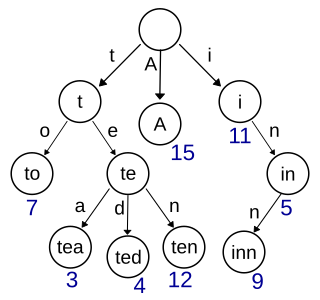In computer science, a B-tree is a self-balancing tree data structure that maintains sorted data and allows searches, sequential access, insertions, and deletions in logarithmic time. The B-tree generalizes the binary search tree, allowing for nodes with more than two children. Unlike other self-balancing binary search trees, the B-tree is well suited for storage systems that read and write relatively large blocks of data, such as databases and file systems.

In computing, a cache is a hardware or software component that stores data so that future requests for that data can be served faster; the data stored in a cache might be the result of an earlier computation or a copy of data stored elsewhere. A cache hit occurs when the requested data can be found in a cache, while a cache miss occurs when it cannot. Cache hits are served by reading data from the cache, which is faster than recomputing a result or reading from a slower data store; thus, the more requests that can be served from the cache, the faster the system performs.

In computer science, a trie, also called digital tree or prefix tree, is a type of k-ary search tree, a tree data structure used for locating specific keys from within a set. These keys are most often strings, with links between nodes defined not by the entire key, but by individual characters. In order to access a key, the trie is traversed depth-first, following the links between nodes, which represent each character in the key.

R-trees are tree data structures used for spatial access methods, i.e., for indexing multi-dimensional information such as geographical coordinates, rectangles or polygons. The R-tree was proposed by Antonin Guttman in 1984 and has found significant use in both theoretical and applied contexts. A common real-world usage for an R-tree might be to store spatial objects such as restaurant locations or the polygons that typical maps are made of: streets, buildings, outlines of lakes, coastlines, etc. and then find answers quickly to queries such as "Find all museums within 2 km of my current location", "retrieve all road segments within 2 km of my location" or "find the nearest gas station". The R-tree can also accelerate nearest neighbor search for various distance metrics, including great-circle distance.
In computing, cache replacement policies are optimizing instructions or algorithms which a computer program or hardware-maintained structure can utilize to manage a cache of information. Caching improves performance by keeping recent or often-used data items in memory locations which are faster, or computationally cheaper to access, than normal memory stores. When the cache is full, the algorithm must choose which items to discard to make room for new data.
A B+ tree is an m-ary tree with a variable but often large number of children per node. A B+ tree consists of a root, internal nodes and leaves. The root may be either a leaf or a node with two or more children.
Extensible Storage Engine (ESE), also known as JET Blue, is an ISAM data storage technology from Microsoft. ESE is the core of Microsoft Exchange Server, Active Directory, and Windows Search. It's also used by a number of Windows components including Windows Update client and Help and Support Center. Its purpose is to allow applications to store and retrieve data via indexed and sequential access.

MonetDB is an open-source column-oriented relational database management system (RDBMS) originally developed at the Centrum Wiskunde & Informatica (CWI) in the Netherlands. It is designed to provide high performance on complex queries against large databases, such as combining tables with hundreds of columns and millions of rows. MonetDB has been applied in high-performance applications for online analytical processing, data mining, geographic information system (GIS), Resource Description Framework (RDF), text retrieval and sequence alignment processing.
A bitmap index is a special kind of database index that uses bitmaps.
Query optimization is a feature of many relational database management systems and other databases such as NoSQL and graph databases. The query optimizer attempts to determine the most efficient way to execute a given query by considering the possible query plans.
Bigtable is a fully managed wide-column and key-value NoSQL database service for large analytical and operational workloads as part of the Google Cloud portfolio.
A column-oriented DBMS or columnar DBMS is a database management system (DBMS) that stores data tables by column rather than by row. Benefits include more efficient access to data when only querying a subset of columns, and more options for data compression. However, they are typically less efficient for inserting new data.

Redis is an open-source in-memory storage, used as a distributed, in-memory key–value database, cache and message broker, with optional durability. Because it holds all data in memory and because of its design, Redis offers low-latency reads and writes, making it particularly suitable for use cases that require a cache. Redis is the most popular NoSQL database, and one of the most popular databases overall. Redis is used in companies like Twitter, Airbnb, Tinder, Yahoo, Adobe, Hulu, Amazon and OpenAi.
Patrick Eugene O'Neil was an American computer scientist, an expert on databases, and a professor of computer science at the University of Massachusetts Boston.

Actian Vector is an SQL relational database management system designed for high performance in analytical database applications. It published record breaking results on the Transaction Processing Performance Council's TPC-H benchmark for database sizes of 100 GB, 300 GB, 1 TB and 3 TB on non-clustered hardware.

A quotient filter is a space-efficient probabilistic data structure used to test whether an element is a member of a set. A query will elicit a reply specifying either that the element is definitely not in the set or that the element is probably in the set. The former result is definitive; i.e., the test does not generate false negatives. But with the latter result there is some probability, ε, of the test returning "element is in the set" when in fact the element is not present in the set. There is a tradeoff between ε, the false positive rate, and storage size; increasing the filter's storage size reduces ε. Other AMQ operations include "insert" and "optionally delete". The more elements are added to the set, the larger the probability of false positives.
In computer science, a fractal tree index is a tree data structure that keeps data sorted and allows searches and sequential access in the same time as a B-tree but with insertions and deletions that are asymptotically faster than a B-tree. Like a B-tree, a fractal tree index is a generalization of a binary search tree in that a node can have more than two children. Furthermore, unlike a B-tree, a fractal tree index has buffers at each node, which allow insertions, deletions and other changes to be stored in intermediate locations. The goal of the buffers is to schedule disk writes so that each write performs a large amount of useful work, thereby avoiding the worst-case performance of B-trees, in which each disk write may change a small amount of data on disk. Like a B-tree, fractal tree indexes are optimized for systems that read and write large blocks of data. The fractal tree index has been commercialized in databases by Tokutek. Originally, it was implemented as a cache-oblivious lookahead array, but the current implementation is an extension of the Bε tree. The Bε is related to the Buffered Repository Tree. The Buffered Repository Tree has degree 2, whereas the Bε tree has degree Bε. The fractal tree index has also been used in a prototype filesystem. An open source implementation of the fractal tree index is available, which demonstrates the implementation details outlined below.

Martin L. Kersten was a computer scientist with research focus on database architectures, query optimization and their use in scientific databases. He was an architect of the MonetDB system, an open-source column store for data warehouses, online analytical processing (OLAP) and geographic information systems (GIS). He has been (co-) founder of several successful spin-offs of the Centrum Wiskunde & Informatica (CWI).
Approximate Membership Query Filter (AMQ-Filter) is a group of space-efficient probabilistic data structures that supports approximate membership queries. An approximate membership query answers if an element is in a set or not with a false positive rate of .
Tim Kraska is a German computer scientist specializing in data systems and the intersection of systems and machine learning. He is currently an associate professor of computer science at the Massachusetts Institute of Technology.








